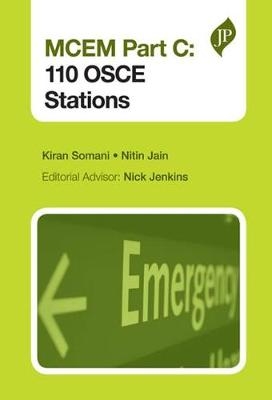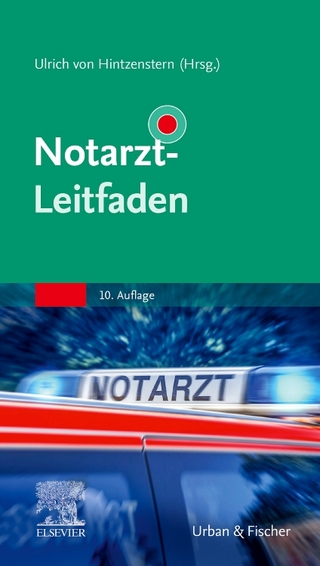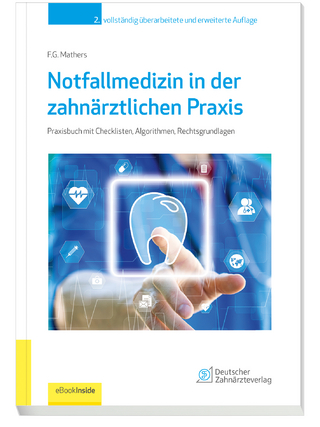
MCEM Part C: 110 OSCE Stations
JP Medical Ltd (Verlag)
978-1-907816-66-6 (ISBN)
- Titel ist leider vergriffen;
keine Neuauflage - Artikel merken
MCEM Part C: 110 OSCE Stations offers a complete and practical skills guide for trainees preparing for the MCEM OSCE exam. Presented in a clear layout, chapters are mapped to the exam circuit to provide structured revision in all the syllabus topics. Featuring a wealth of practice stations, this book provides the essential clinical knowledge and practical skills necessary to succeed in the MCEM Part C OSCE exam.
110 practice stations, reflecting the breadth of skills and topics tested in the actual exam
Provides concise summaries of all the stations examined, including history taking, communication skills and procedures
Addresses every aspect of the exam, including the circuit, content and marking
Highly illustrated to improve understanding of key concepts
Kiran Somani BA (Hons) MBBS MRCP DTM&H FCEM Post CCT Fellow in Emergency Medicine, University Hospital Southampton, UK Nitin Jain MBBS MS Orth MRCS Eng FCEM Clinical Superintendent at Sydney South West Area Health Service, New South Wales, Australia Nick Jenkins MBBS FCEM DipMedEd FHEA Consultant in Emergency Medicine, Wexham Park Hospital, UK
CONTENTS
Preface
MCEM Part C OSCE exam – Curriculum summary
How to use the book
Principles for OSCE success
Preparation/training/practice – How to prepare for the exam
Practicalities – What to expect on the day
Additional resources for the exam
Chapter 1: History taking, including acute presentations
Introduction
Abdominal pain, renal colic
Abdominal swelling, change in bowel habit, PR bleed
ALTE
Back pain
Blackout, collapse, syncope, seizure
Chest pain
Diabetes, hypoglycaemia
Dizzines, falls
Dysphagia, sore throat
Febrile convulsion
Fever, GU
Haematuria
GI bleed
Headache
Jaundice
Needlestick
Limping child
Palpitations
Rash
Sexual history, HIV, PID, PV bleed
Shortness of breath, haemoptysis, cough
Snake bite
Weakness (non-stroke), TIA, CVA
Weight loss
Chapter 2: Communication skills
Introduction
Angry parent, patient: missed fracture, diagnosis, not prescribing antibiotics, no x-ray for pulled elbow
Breaking bad news: death, CVA, head injury, stopping ventilation
Capacity
CDU ward round
Confidentiality: police
Consent: blood transfusion, Gillick
Difficult referral
Driving post seizure
Major incident preparation
NAI
Prioritising patients, CDU ward round
Teaching
Chapter 3: Systems examinations
Introduction
Cardiovascular
Eye examination, slit lamp, red eye
Gastroenterology
Neurology: upper limbs
Neurology: lower limbs
Neurology: cranial nerves
Respiratory
Thyroid examination, status
Chapter 4: Joint examinations
Introduction
Ankle
Back
Elbow
Hand
Hip
Knee
Neck
Shoulder
Chapter 5: Psychiatry
Introduction
Depression
DSH, suicide risk: SAD PERSONS, poisoning: toxidromes
Mania
Mental state examination, mini mental state examination
Psychosis
Substance misuse, aggressive, disturbed behaviour
Chapter 6: Procedures/Teach a colleague
Introduction
ABG, arterial cannulation
Airway assessment, protection
Ascitic tap, drain
Central venous cannulation
Chest drain
Clearing a c-spine
Connection to a ventilator
DC cardioversion
FAST, aorta, vascular access scan
Handwashing
Intraosseous needle insertion
Knee aspiration
Lumbar puncture
Nasal packing
Nerve block: femoral
Opthalmoscopy
Otoscopy
Peak flow, inhaler, spacer, nebuliser technique
Performing an ECG
Phlebotomy, cannulation, blood cultures
Plastering
Pleural tap and aspiration, pneumothorax
Rapid sequence intubation
Surgical airway
Teach while managing an acute situation: airway, anaphylaxis
Thomas splint, Donway splint
Urinary Catheter
Vaginal examination, speculum examination
Wound management, suturing
Chapter 7: Resuscitation, including major presentations
ALS introduction
Anaphylaxis
BLS
Delivering a baby normal, abnormal circumstances
Pacing
PEA/asystole
Periarrest/cardioversion
Post-resuscitation care
Pre-ecplampsia
Pregnancy, OD, hypothermia, drowning
VF/VT
ATLS introduction
Burns
Cardiac tamponade, thoracotomy
Haemothorax, pneumothorax
Head injury: airway problem, neuroprotection
Pregnancy
Shock, bleeding from abdomen or pelvis
Trauma: airway problem
Chapter 8: Closing comments
Final preparation
Managing an OSCE station you didn’t expect
| Erscheint lt. Verlag | 6.1.2014 |
|---|---|
| Zusatzinfo | 140 Illustrations, unspecified |
| Verlagsort | London |
| Sprache | englisch |
| Maße | 160 x 240 mm |
| Themenwelt | Medizin / Pharmazie ► Medizinische Fachgebiete ► Notfallmedizin |
| Medizin / Pharmazie ► Studium | |
| ISBN-10 | 1-907816-66-6 / 1907816666 |
| ISBN-13 | 978-1-907816-66-6 / 9781907816666 |
| Zustand | Neuware |
| Haben Sie eine Frage zum Produkt? |
aus dem Bereich


